The charts that matter: can Japan lift the iron coffin lid?
Japan’s Topix index has hit the “coffin lid”. John Stepek looks at where it might go from here, and at the rest of the charts that matter.

Welcome to your weekend edition, where we take a look through the charts that matter and catch up on anything else that we missed during the week.
One market has to make a guest appearance this week Japan's Topix index. As I've mentioned before, Japan is at an interesting juncture right now.
Jonathan Allum at broker SMBC Nikko describes it as "the iron coffin lid". Basically, it's the Topix index's 1,800 level. Ever since the crash of the early 1990s, the Japanese stockmarket has failed to break through this level, despite challenging it on several occasions.
MoneyWeek
Subscribe to MoneyWeek today and get your first six magazine issues absolutely FREE

Sign up to Money Morning
Don't miss the latest investment and personal finances news, market analysis, plus money-saving tips with our free twice-daily newsletter
Don't miss the latest investment and personal finances news, market analysis, plus money-saving tips with our free twice-daily newsletter
A convincing breakout would be very bullish indeed, as it would convince many technical traders that the only way is up for Japan.
The Topix poked its head above the level earlier this week hitting its highest level in more than 25 years but has yet to convincingly punch through. It's now sitting at around 1,800.
In any case, it's worth keeping a close eye on particularly as the US market has run into a bit of a struggle in trying to keep up its own momentum this week. The yen meanwhile has also been strengthening somewhat this week another headwind for Japanese stocks.
In other words, it could go either way. I'm certainly sticking with Japan but don't be surprised if it needs to drop back and have another run-up before it finally breaks through.
Now we'll turn to our other charts, but first, if you missed any of this week's Money Mornings, here are the links to catch-up.
Monday: What the purge in Saudi Arabia means for the price of oil
Tuesday: Prepare your finances for more interest-rate rises
Wednesday: Three reasons why bitcoin could go to $100,000
Thursday: The UK housing market is in deep freeze but will that mean lower prices?
Friday: How America's roaring '20s paved the way for the Great Depression
Gold rallied again this week. The purge in Saudi Arabia has added to the general sense of jitters in the market, and the dollar has also lost steam this week. Those things both bode well for gold and I'd be surprised if this rally doesn't gently continue.

(Gold: three months)
The US dollar index a measure of the strength of the dollar against a basket of the currencies of its major trading partners gave back some ground this week as concerns that Donald Trump's much-hyped tax reform plans would be delayed.
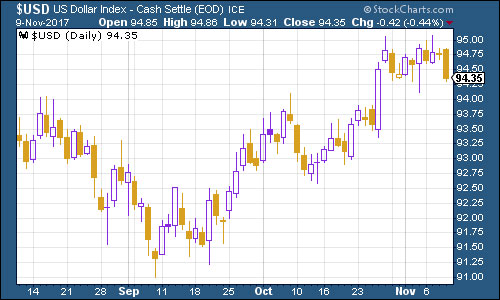
(DXY: three months)
The yield on ten-year US Treasury bonds dipped again this week, and continues to hover below the 2.4% mark that's now seen as a major line in the sand by many analysts.

(Ten-year US Treasury: three months)
Copper took a big hit this week, although it's still holding on above $3 a lb. It's partly to do with the recent strength in the dollar, partly consolidation after copper's recent strong run, and also because of somewhat weaker Chinese imports.
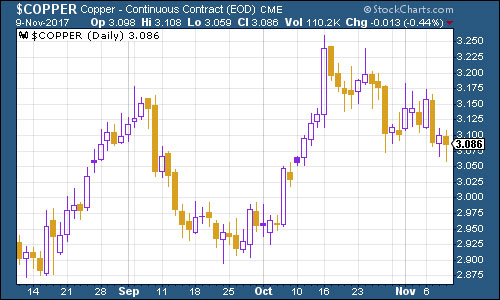
(Copper: three months)
Bitcoin has taken a bit of a breather this week (for once), although it's still rattling around the $7,000 a coin mark now. The crypto space' continues to be mindbogglingly excitable, but it's little wonder with these sort of paper profits being made.
My colleague Dominic Frisby offered up his own bull market take on bitcoin this week, sketching out scenarios that could take it to $100,000 just read it with a keen awareness that Dominic is sketching out theoretical possibilities rather than likelihoods!
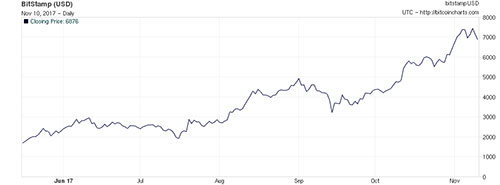
(Bitcoin: six months)
This week, weekly US jobless claims remained low. The four-week moving average slipped back to 231,250 as claims came in at 239,000. According to David Rosenberg of Gluskin Sheff, when US jobless claims hit a "cyclical trough" (as measured by the four-week moving average), a stockmarket peak is not far behind (on average 14 weeks), a recession follows about a year later.
As the chart below shows, 231,250 is another new cyclical trough (the previous one was last week, the one before on May 20th). So we could still be a way from the peak.
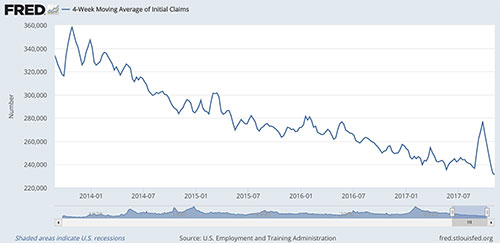
(Four-week moving average, US jobless claims, since 2014)
The oil price (as measured by Brent crude, the international/European benchmark) continued to rally this week, very much helped by the news of the purge in Saudi Arabia and the ensuing wave of fear over what it might mean for geopolitics in the Middle East. It's well above the $60 a barrel level. We look at what it all means for investors in the current issue of MoneyWeek magazine.
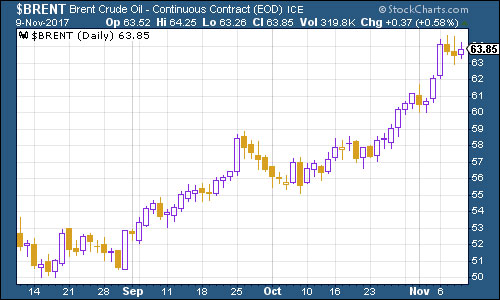
(Brent crude oil: three months)
Finally, internet giant Amazon confirmed that the market is still in love with tech, as it ticked even higher this week. This week also saw the launch of the FANG futures contract. This is a small basket of tech stocks (it includes all the biggest names) which can now be traded with leverage (ie borrowed money) via one convenient financial instrument.
It's another sign that the market is top-py. But there have been so many of those signs in recent months and even years that it's hard to keep count, and you start to become anaesthetised. I guess that's a toppy sign in itself
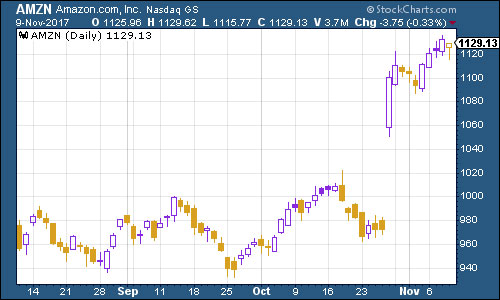
(Amazon: three months)
Get the latest financial news, insights and expert analysis from our award-winning MoneyWeek team, to help you understand what really matters when it comes to your finances.
John Stepek is a senior reporter at Bloomberg News and a former editor of MoneyWeek magazine. He graduated from Strathclyde University with a degree in psychology in 1996 and has always been fascinated by the gap between the way the market works in theory and the way it works in practice, and by how our deep-rooted instincts work against our best interests as investors.
He started out in journalism by writing articles about the specific business challenges facing family firms. In 2003, he took a job on the finance desk of Teletext, where he spent two years covering the markets and breaking financial news.
His work has been published in Families in Business, Shares magazine, Spear's Magazine, The Sunday Times, and The Spectator among others. He has also appeared as an expert commentator on BBC Radio 4's Today programme, BBC Radio Scotland, Newsnight, Daily Politics and Bloomberg. His first book, on contrarian investing, The Sceptical Investor, was released in March 2019. You can follow John on Twitter at @john_stepek.


